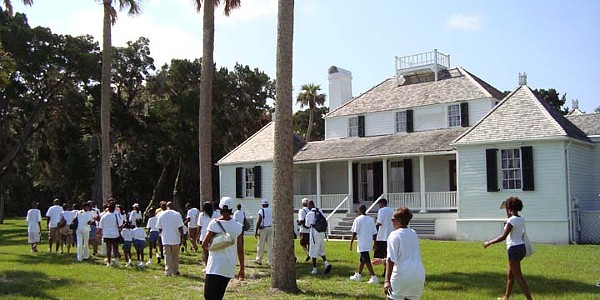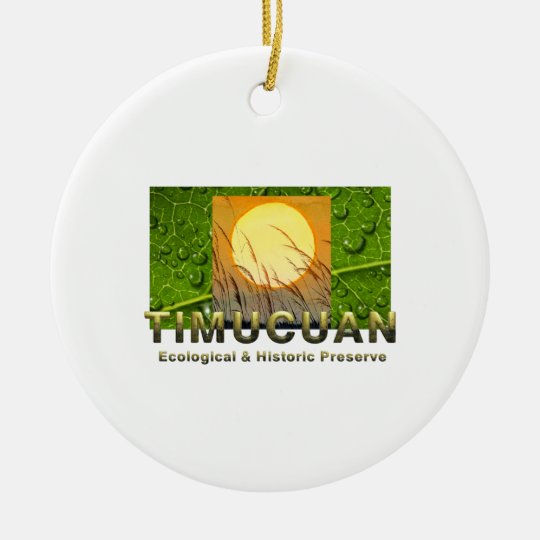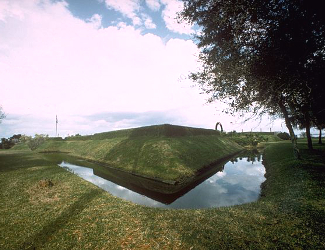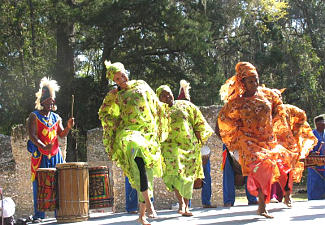
Photo above: Etching of Kingsley Plantation on Fort George Island, circa 1878. Source: Wikipedia Commons/Florida Memory Project. Right: Fort George River today from the Kingsley Plantation. Photo courtesy National Park Service.

Timucuan Ecological and Historic Preserve
The name is not well known outside north Florida, stemming from the Timucua Indians of the region, although the history and nature within its confines certainly should be. From failed French colonies long gone from Fort Caroline, to the Kingsley Plantation with its harsh slave history and well-preserved buildings and stories, to the intercoastal waterway, wildlife, and marshland that brims with activity both above and below the surface. For those that like a little nature with their american story, there will be that in abundance here. Timucuan is just another in a growing list of national nature oriented national parks with so much history in them, no designation really does them justice. So go to Timucuan and see for yourself. Don't forget to take in the sunset at Fort George Island, ... as you can see, it's spectacular.
Sponsor this page for $100 per year. Your banner or text ad can fill the space above.
Click here to Sponsor the page and how to reserve your ad.

Timucuan Then
Over 10,000 years ago, the Paleo-Indians made their way down the Florida peninsula to Biscayne. At that time, the Florida Peninsula might have been twice as wide and the area of Biscayne more a savannah than bay. Thousands of years later, the Tequesta would be the indigenous people of Biscayne Bay, until European settlement began in the 1600s, causing their demise. It would come to the tribes of the Creek from Georgia to inhabit this land later, giving rise to the Seminole and Miccosukee.
Fort Caroline - French explorer Jean Ribault arrived in May 1562, meeting the Timucua Indians, then bringing two hundred soldiers and settlers two years later to make settlement along the St. John's River. The Timucua assisted in the building of Fort Caroline and a village, before deciding against true friendship. Of course, the Spanish, who had settled Florida and the Caribbean in a more vibrant manner, did not like the French settlement, fearing French raids of their ships plying the coast. The first year was harsh and the colony on the verge of abandonment when Ribault himself returned with six hundred men and supplies. But his return prompted the Spanish to send Admiral Menendez to end the colony; he would capture Fort Caroline on September 20, 1565, then follow the retreating men of Ribault and massacre them.
Kingsley Plantation - The plantation on Fort George Island was owned by many planters, including namesake Zephaniah Kingsley, who arrived in 1814. His wife, Anna, a slave, was eventually freed, and also owned slaves. Kingsley would own four plantations, thirty-two thousand acres overall, and two hundred slaves. The slaves on Kingsley Planation lived in thirty-two tabby cabins.
Ribault Club - In the 1920s, Fort George Island became a winter resort with the club built in 1928. The resort would not succeed as the depression sapped the attempts at further development.
Photo above: The Kingsley Plantation grounds. Date unknown. Courtesy, the Historic American Buildings Survey, Library of Congress. Below: The Fagan family at Kingsley Plantation. Source: National Park Service.

Timucuan Now
Since 1953, the National Park Service has told the story of Fort Caroline at the approximate location of its settlement. The first reconstructed fort, built in 1964, was destroyed by Hurricane Dora. The second reconstruction stands today as a full replica of the small fortification.
Kingsley Plantation, with many intact buildings, remains on sixty of the original one thousand acres. The plantation house, built in 1798, is the oldest plantation house in the state of Florida.
Beyond the historic elements of the park, opportunities for recreation abound with many beaches, boat ramps, kayak trails, and hiking exploits. There are guided tours and kayaks for rent for those that don't have their own.
The preserve itself has only been around since 1988 and is one of those hybrid parks in cooperation with the city of Jacksonville, state of Florida, and the National Park Service, but not of that truly matters. What you will see here predates civilization in its waterways and natural wonders, updates your history of the area in the Timucua culture and efforts to establish French colonies when the Spanish did not want them, because they were just down the road settling St. Augustine and wanted to build their own mission along the St. John's River. Timucuan reminds us of a time when slavery and plantation life impacted the region, down to a Kingsley freed slave, wife of the owner, who actually owned others. So while this may not have the notoriety of the Everglades, it sure has that nature, and while the story of its early settlement may not rise to the success of that oldest city to the south, for brutal historic reasons, Timucuan Ecological and Historic Preserve is a growing treat for the over one million visitors who know of its charms, hard history, and pursuits. Well worth a stop on your journey south, whether you've got nature or fun on your mind.
T-Shirts and Souvenirs

Timucuan Ecological and Historic Preserve T-Shirts and Souvenirs from the official merchandise of America's Best History. Great for your next Florida adventure or to remember one you've already had.

Tumucuan
Things You Should Not Miss
1. For those coming to the park for the first time, stop by the main Visitor Center at the Fort Caroline unit. Great exhibits and orientation, plus the ability to wander over to two other areas of the park; the six hundred acre Theodore Roosevelt Area and the Spanish Pond.
2. Tour the grounds and plantation house at Kingsley Plantation. As of 2016, the plantation house was only open for tours on weekends, so best to check when one is available before coming. A walking tour of the plantation is still worthwhile, but the house tour surely adds to your experience.
3. Just walk or boat the nature here. Timucuan has such a diverse history, but it also has the natural history of all those beaches, marshes, and waterways. Great place to bring your canoe and paddle, if that's what your desire likes and your ability allows. There's plenty of hiking trails, too, from the Saturiwa Trail on Fort George Island to the trails in the Theodore Roosevelt hardwood forest and wetlands area near Fort Caroline.
Photo above: Planter's house on Fort George Island. Below: Reconstruction at Fort Caroline National Memorial. Photos courtesy National Park Service.






